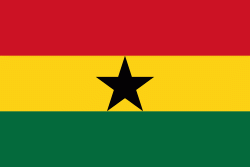Amansie West District (Amansie West)
It covers an area of 1,364 square kilometers and has a population of 144,104 according to the 2010 census. Aside from its capital, the main settlements in the district include Mpatuam, Pakyi No. 1, Antoakrom and Esuowin.
There are 4 main ethnic groups in the district: the largest group of people is the Akans (86.4%), with three other smaller groups the Northerners (9.7%), the Ewe (3.6%) and the Ga (1.1%). They are also predominantly Christians (79.4%), with some Muslims (8%), and smaller number belonging to other sects or indigenous beliefs.
Map - Amansie West District (Amansie West)
Map
Country - Ghana
 |
 |
| Flag of Ghana | |
The Bono state existed in the area that is modern day Ghana during the 11th century. Kingdoms and empires such as Kingdom of Dagbon in the north and the Ashanti Empire in the south emerged over the centuries. Beginning in the 15th century, the Portuguese Empire, followed by other European powers, contested the area for trading rights, until the British ultimately established control of the coast by the 19th century. Following over a century of colonial resistance, the current borders of the country took shape, encompassing 4 separate British colonial territories: Gold Coast, Ashanti, the Northern Territories, and British Togoland. These were unified as an independent dominion within the Commonwealth of Nations. On 6th March 1957, Ghana became the first country in Sub-Saharan Africa to achieve sovereignty. Ghana subsequently became influential in decolonisation efforts and the Pan-African movement.
Currency / Language
| ISO | Currency | Symbol | Significant figures |
|---|---|---|---|
| GHS | Ghanaian cedi | ₵ | 2 |
| ISO | Language |
|---|---|
| AK | Akan language |
| EN | English language |
| EE | Ewe language |
| TW | Twi |















